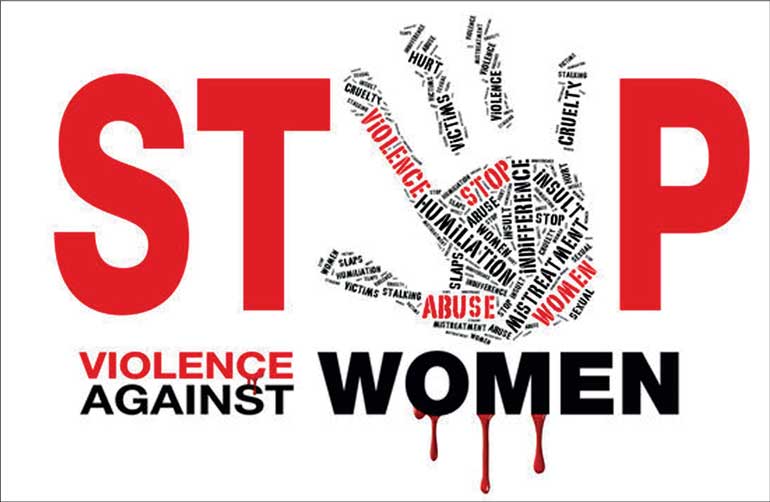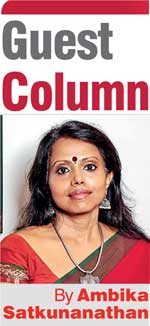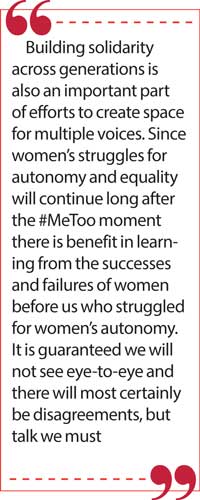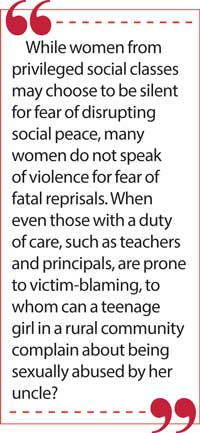Tuesday Dec 30, 2025
Tuesday Dec 30, 2025
Thursday, 8 July 2021 00:00 - - {{hitsCtrl.values.hits}}

Violence, particularly sexual violence, directed at women and children tends to be the dominant form of communication to assert the right to claim the entitlements the male body has been promised. If she objects, she faces reprisals. The reprisals women face range, from being ridiculed for not having a sense of humour and labelled a man-hater, to being killed for resisting rape and sexual harassment
She needed to learn that anger is not an inherently bad emotion. She needed to know that it is powerful, justified, necessary. That she is responding correctly to injustice or someone trying to hurt her or harm done to people she loves. That so much of what makes her angry is worthy of that anger
– Sarah Kuhn –
 The burdens that women bear
The burdens that women bear
It was November 2017. The 31st day ritual after my father’s death. I went to Mutwal accompanied by a person who had knowledge of the rituals I had to perform. In a damp, dreary and depressing large room I performed rituals replicating the rituals I had performed at the funeral. I then walked to the beach to dissolve his ashes.
I was walking back to the vehicle alone. The person who accompanied me was a few metres ahead of me. A policeman standing by the road made a couple of comments directed at me. I was in a daze at the time and what he said did not really register. It was only a couple of hours later it dawned on me that he had made comments about my appearance.
When I realised what he had said, I was angry at the policeman, but angrier at myself, a Commissioner of the Human Rights Commission, for not doing what I would have normally done; stopped, asked for his name, noted his badge number, and written a complaint to the Inspector General of Police. I was angry with myself for not challenging him. I was embarrassed by what I felt was my failure in not confronting him. It bothered me for days. The embarrassment, which should have been his bear, had wrongly become mine.
Sexual harassment is common, it is pervasive and no woman is immune from it. Due to social conditioning, sometimes, women who are harassed feel guilty for not challenging it. As women in Sri Lanka share their experiences of harassment, friends tell me they are angry with themselves or regret not complaining of workplace sexual harassment at the time, because, perhaps then, others would not have been harassed by the same person years later. They are angry at themselves for finding coping mechanisms through avoidance tactics that consumed time and energy. Our self-anger shows that, most often, women bear the emotional burden of protecting other women from harassment even while struggling with their own pain and trauma.
The known abuser and maintaining social peace
The stranger on the street, the unknown abuser is always easier to demonise, but how is the known harasser/abuser within our own social circles treated? Most often, the issue is simply avoided. The phrase, ‘it’s not nice no?’, which is commonly used to avoid social confrontation and awkwardness and maintain social peace, is employed to prevent any discussion on the issue.
The powerful boys’ club closing ranks to protect alleged abusers as allegations of harassment and abuse emerge, though unsurprising is nevertheless disturbing. This is particularly so when the men appear or claim to be politically progressive. Their progressiveness does not seem to extend to issues of sexual and gender-based violence when it involves their colleagues or friends, pointing to the deep-seated misogyny and sexism within even supposedly progressive circles.
Subha Wijesiriwardena, a feminist activist, in an insightful piece, discusses how women of privileged social classes who are connected by family, school and other networks grapple (or do not grapple) with allegations of sexual harassment and abuse by those known to them, and suggests means to address them in a principled manner.
While women from privileged social classes may choose to be silent for fear of disrupting social peace, many women do not speak of violence for fear of fatal reprisals. When even those with a duty of care, such as teachers and principals, are prone to victim-blaming, to whom can a teenage girl in a rural community complain about being sexually abused by her uncle?
 Why are men violent towards women?
Why are men violent towards women?
Philosopher and legal scholar Martha Nussbaum uses the term ‘gender pride’ to explain the reason for men’s violence against women. She says, ‘More or less what all men have for long centuries been raised to have is a sense they do not need to take the woman’s autonomy and her full subjective reality seriously. She is there as something to serve their interest.’ When a man refuses to see women as autonomous persons with equal rights it leads to objectification, i.e. the woman becomes a thing that can be harassed, abused and subjected to lewd jokes.
Anthropologist Veena Das states that violence, particularly sexual violence, directed at women and children tends to be the dominant form of communication to assert the right to claim the entitlements the male body has been promised. If she objects, she faces reprisals. The reprisals women face range, from being ridiculed for not having a sense of humour and labelled a man-hater, to being killed for resisting rape and sexual harassment.
To understand and address violence against women we must inquire into the construction of masculinity. What does our notion of masculinity expect/demand of men? What are the direct and indirect means through which this is taught and normalised? How does it impact men? Toxic masculinity adversely impacts men too, as described by Veena Das thus, ‘The blows of the sculptor’s chisel which define the outlines of the manhood, leave many scars which cannot be smothered over by the unrealisable dreams of future rewards as part of male dominion.’
The “angry woman” and the normalisation of misogyny
Social perceptions of what is considered to be appropriate behaviour of women shape public reaction to women’s responses to violence. Generally, women’s anger is perceived to be dangerous and undesirable, and women who show anger are labelled hysterical, unstable or emotional. Women’s anger as a response to casual every-day sexism, normally encountered in the form of sexist jokes, or men speaking over women, is met with derision and viewed as ‘over-reaction’.
Author Sarah Kuhn says that during childhood she was taught that her anger was a monster she had to control. It is only much later that she came to realise her anger stemmed from the fact ‘I was also fighting daily battles that were invisible to me, wars I did not realise were wars…microaggressions, macroaggressions…just plain old aggressions’.
Women are taught and told, in direct and indirect ways, to tolerate causal sexism and every day acts of discrimination and disrespect, which only serves to normalise it. Kuhn recalls the ‘every day moments. The things that are supposedly inconsequential. The moments where I’d laughed something off or acted like it wasn’t a big deal because I was so used to it.’ Even supposedly liberal and progressive circles are not exceptions to the normalisation of casual sexism, which is tolerated, sometimes even indulged because ‘boys will be boys’.
Sexual harassment is hence on a spectrum of different forms of sex discrimination and diminishes a person’s life chances and opportunities. Some women who spoke of the harassment they experienced said they left their jobs or careers as a result. This marginalises women and places them in a socially and economically disadvantaged position, which in turn exacerbates their vulnerability to violence. Sexual violence therefore does not exist in a vacuum but is part a continuum. It is part of ‘every day violence’, which we often fail to recognise or even if we recognise, refuse to acknowledge and address.
Failure to understand sexual violence as part of a continuum means that sexual violence comes to our notice only when it is particularly horrific or brutal and committed by persons viewed as monsters. There are two reasons perpetrators are portrayed as evil monsters. Firstly, it makes it easier for people to deal with the fact another human being is capable of such brutality and inhumanity. Secondly, thinking that only monsters are capable of committing acts of violence makes it easier to deny the entrenched, every-day nature of violence, especially violence committed by those within our social circles. It helps people distance themselves from it by saying ‘a monster did it. No one I know would ever do such a thing’. The logic is, if no one we know engages in such acts, how can we be complicit?
You become complicit by what you ignore, what you tolerate and what you accept because it is convenient or beneficial to you. Examples of this are prominent women who function as foot soldiers of patriarchy by, for instance, questioning why only women ‘shout sexual harassment’ and advising women to use the 64 wiles, which are supposedly ‘inherent’ to them, to ‘benevolently’ to get what they want.
 ‘Boys will be boys’: the need to move beyond legal remedies
‘Boys will be boys’: the need to move beyond legal remedies
Discussions on how #MeToo allegations should be addressed have focused mainly on institutional and procedural changes, such as laws, anti-sexual harassment policies and the establishment of independent panels in each institution to inquire into allegations of sexual harassment. The deep-seated structural and systemic elephant in the room, i.e. patriarchy, is yet to be mentioned as the root cause of sexual harassment.
Discussions on solutions that ignore patriarchy are destined to fail in addressing harassment in a meaningful way. Why? Because patriarchy means that in many workspaces, those in positions of power are mostly men. While many of these men may not harass, they do still think that women who demand equality and recognition of their autonomy or complain about sexist jokes or gender discrimination are being too sensitive or strident.
For instance, women are repeatedly told, ‘don’t take it seriously,’ ‘relax’ and ‘have a sense of humour’. The entrenched, yet unacknowledged sexism which has been normalised in a patriarchal society, is the reason anti-sexual harassment policies or inquiry panels may not work effectively even if/when institutions establish them.
A truth often denied but is evidenced by historical practice, is that the application of a law or policy is shaped, unfortunately, by the biases and prejudices of those applying them. Sure, we need rules and processes and everyone needs to know of them, but they have to be followed and implemented. Sri Lanka is the perfect illustration of how the lack of respect for the rule of law only serves to weaken the law and entrench impunity.
 Points of tension and points of cohesion
Points of tension and points of cohesion
Women have resorted to social media campaigns of shaming without naming since institutional and legal structures and processes have failed them. While this method is powerful, we should remember that throughout history shame has been weaponised against women to control their bodies, sexuality, lives and even burn them at the stake. It is undeniable there is tension between the need for due process and shaming without naming, which can be resolved only through extensive and sometimes uncomfortable dialogue.
Another point of tension is likely to be the law-and-order carceral approach to violence against women adopted in past struggles and the increasingly abolitionist position of present activists. Acknowledging that the carceral approach of locking people up and throwing away the key is most often preferred because it absolves society of any responsibility, will enable more meaningful and honest solutions.
Such acknowledgment is part of ensuring our actions do not validate and entrench the oppressive structures of a discriminatory, militarised and violent state. Instead, our interventions should be founded upon the recognition of the banality and normalisation of the spectrum of every day violence women experience that is embedded in institutional structures and social processes.
Building community and solidarity when systems have failed
Women use social media and anonymise experiences to sometimes, as feminist Sachini Perera says, only to share and be heard. Some women may want justice, but not immediately, as they may not feel ready to face reprisals and the enormous emotional and financial price they will have to pay for it. Some may do it to warn others against known predators. In the midst of multiple, and sometimes contradictory voices with multiple competing intentions and needs, it is possible to get caught in the maelstrom and feel overwhelmed. Within this turmoil, the challenge is to create space for these voices and stand in solidarity with survivors and those resisting attempts to silence survivors.
Building solidarity across generations is also an important part of efforts to create space for multiple voices. Since women’s struggles for autonomy and equality will continue long after the #MeToo moment there is benefit in learning from the successes and failures of women before us who struggled for women’s autonomy. It is guaranteed we will not see eye-to-eye and there will most certainly be disagreements, but talk we must.